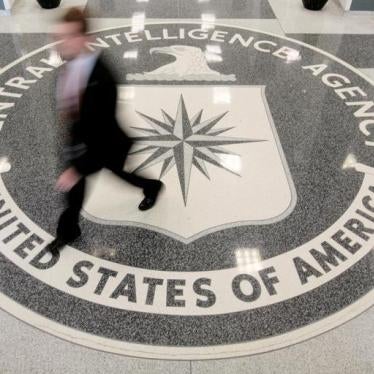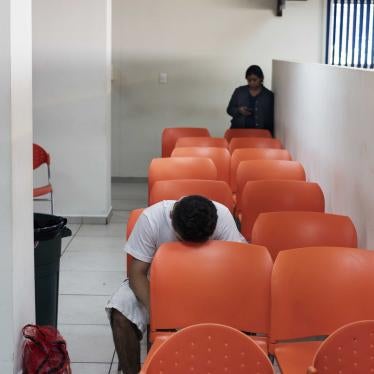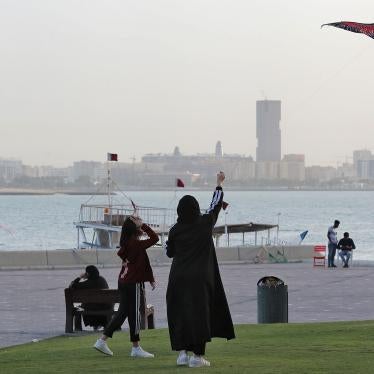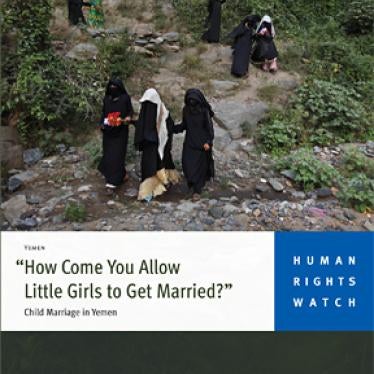Prepared Testimony of Laura Pitter
Senior National Security Counsel
Human Rights Watch
North Carolina Commission of Inquiry on Torture
Raleigh, North Carolina
November 30, 2017 – December 1, 2017
Dear Co-Chairs and Commissioners of The North Carolina Commission of Inquiry on Torture:
When I went to Libya in March 2012 for Human Rights Watch, I expected to find some new information about United States Central Intelligence Agency renditions. I was following up on documents Human Rights Watch colleagues had found abandoned in the Libyan intelligence ministry as then-Libyan leader Muammar Gaddafi’s forces were fleeing Tripoli. The documents, which we called the “Tripoli Documents,” exposed CIA involvement in several secret renditions of Gaddafi opponents who had been living abroad, back to Libya. What surprised me was to find significant levels of cooperation between the US and Libyan governments on the renditions, the high number of them, and the fact that many of those rendered were held first by the CIA in secret prisons in Afghanistan for long periods and brutally tortured prior to being sent back.
I started by tracking down those named in the Tripoli Documents and interviewing them. This led me to others who had been in similar situations. In all, as part of the report we published in 2012, Delivered Into Enemy Hands, we documented the rendition of 14 Libyans, all members of what was then known as the Libyan Islamic Fighting Group (LIFG), back to Libya.[1] All the LIFG members we interviewed said they had no conflict with the US, were not allied with Al Qaeda or any other terrorist group, and that their sole aim was the overthrow of Gaddafi. Nine of these renditions were clearly conducted by the US, two with assistance of the United Kingdom. The others contained less evidence of US or other Western government involvement in the actual transfer, though there were indications that Western governments, in most cases the US, were involved in the initial apprehensions and subsequent interrogations. Five of the 14 individuals were detained in US-run secret prisons in Afghanistan for between eight months and two years and tortured there prior to being sent back to Libya. Many of the people profiled were telling their stories for the first time because until recently they had been locked up in Libyan prisons, released only when the uprising against Gaddafi began. Had there been no uprising, their stories might remain untold today.
The renditions we documented occurred only after the US, the UK, and Libya began to mend relations after a long period of discord. As part of this rapprochement, Gaddafi began supplying names of his enemies to the US and the UK, claiming they posed a terrorist threat. The countries increased intelligence sharing, and the US began to arrest many of these individuals in various parts of the world and render them, unlawfully without due process, back to Libya—a country with a known record of torture. Ten of the 14 individuals were sent back within about a year of the rapprochement, seven within the first five months. The remaining individuals were sent in the years following.
There are many compelling accounts contained in our report but for the purposes of this hearing, I will focus on those connected to Aero Contractors. Flight records on file with Human Rights Watch connect two of the cases to Aero. The Rendition Project has connected the same two, plus another case, to the company. One of the planes Aero used is also mentioned in the trove of documents we found. Tripoli Document 2233 shows that the CIA and MI6, the UK intelligence agency, proposed to use Aero Boeing jet, tail number N313P, to ferry former CIA deputy director Steve Kappes, and then MI6 director of counterterrorism operations, Mark Allen, to Libya on October 19, 2003, to carry out some of the rapprochement negotiations.[2]
The CIA used the same plane to render one of one of Gaddafi’s most sought-after enemies, Abdul Hakim Belhadj, leader of the LIFG, and his then-pregnant wife, Fatima Bouchar, back to Libya several months later. Belhadj and Bouchar had been on their way from China to London where they planned to seek asylum, not knowing that a rapprochement between Libya the UK, and the US was in the works. Chinese authorities however diverted them to Kuala Lumpur where they were detained by Malaysian authorities for 13 days.[3] Belhadj was finally told they could go to London but only through Bangkok. He and his wife tried to travel this route but when they reached Bangkok, they were detained in a room at the Bangkok airport by the CIA for what they said was about five days.[4]
A cable we found from the CIA to the Libyan intelligence agency dated March 4, 2004, Tripoli Document 2173, thanks Libya for the “hospitality” it showed CIA officers during a recent visit, remarks that discussions had during that visit were “very productive”; pronounces that the CIA is “committed to developing this relationship,” for the “mutual benefit” of both services. It then goes on to say that the CIA is also “committed to rendering” Belhadj, who they knew was being detained in Malaysia, to Libyan custody. Two days later Tripoli Document 2171 shows that the CIA sent Libya a flight plan for the “rendition” of Belhadj.”[5]
This flight plan corresponds with Eurocontrol flight records on file with Human Rights Watch that show a Boeing jet with tail number N313P, which was operated by Aero Contractors, scheduled to leave Dulles airport in Washington, D.C. on March 7, 2004 at 2:51 a.m. and land in Tripoli the same day at 12:01 p.m. local time. The plane then disappears from Eurocontrol’s flight records until March 9, 2012 when a flight plan was filed for a departure from Misrata Libya on March 9 at 4:47 p.m. for Palma Majorca, an island off the coast of Spain. The Rendition Project has informed Human Rights Watch that they also have flight records for an Aero Contractors N313P flight from Thailand to Libya, March 8-9.
While in CIA custody in Bangkok, Belhadj said he was blindfolded, “stripped and beaten,” forced to remain naked, hung against a wall by one arm and then by one leg, and put into a tub with ice. He was also forced to wear earmuffs that were only removed when his captors blasted his cell with loud music or when he was being interrogated. Belhadj said they gave him no food and refused to get him a doctor when he told them he needed one. Bouchar said she was separated from her husband, chained by her wrist to a wall and to the floor by both ankles. She also said they gave her no food though they did give her water. Tripoli Document 2172 shows that the CIA knew Bouchar was four months pregnant at the time.
Both Belhadj and his wife were bound in different ways but put on the same plane back to Libya on March 9. Belhadj was handcuffed and blindfolded and his hands tied to his legs. He said he was crouched over, unable to stand or lie down for the entire 17-hour journey. Bouchar said her captors forced her to lie down on a stretcher and bound her from head to toe with tape so tightly that she was unable to move. They wound the tape around her head, covering her eyes before putting a hood and earmuffs on her. She was not able to move, to hear or see. She was not told where she was being taken or that her husband was on the plane. Only upon arrival in Libya did she hear a man grunting in pain, and realized her husband was with her.
After arriving in Libya, Bouchar was held in a cell for another four months until three weeks before she gave birth to her son. Belhadj said right after he arrived in Libya he was brought directly to the Libyan intelligence minister, Musa Kusa, who was standing right in front of him when his blindfold was removed. “I’ve been waiting for you,” Belhadj said Kusa told him. Belhadj was held for six more years, five of them in solitary confinement. He was tried for crimes against the state in 2008, never given a chance to meet with his lawyer, and sentenced to death, though his sentence was never imposed.
Aero appears to have been involved in two other renditions documented in our Delivered Into Enemy Hands report - that of Saleh Hadiyah Abu Adbullah Di’iki and Mustafa Salim Ali el-Madaghi. Both were LIFG members living in Mauritania at the time of their arrests, which occurred for Di’iki on October 12, 2003 and for Madaghi on February 5, 2004. Di’iki said he was detained for several weeks in Mauritania, then transferred to Morocco, where he was held for about another month before being transferred to Afghanistan, sometime in January 2004, though he was not sure of the exact date. Di’iki was transferred from Afghanistan to Libya on August 22, 2004. Madaghi also said he was transferred from Mauritania to Morocco. But unlike Di’iki he was not transferred to Afghanistan. Instead, he was held in Morocco from the end of March until May 5, 2004 when he was rendered back to Libya.
Di’iki said that before he was transported to Afghanistan, his guards took him to a place where he could hear a plane. Men in military uniform and facemasks cut off all his clothes with scissors, diapered him, put patches over his eyes, plugs in his ears, and a hood over his head. They wrapped him in adhesive tape all around his head. Every time they moved him from place to place, they went through this same procedure. They took him to the plane, threw him in the back and lay him on one side, bound by a rope, he said. From time to time someone he believed was a doctor would come around and put something on his finger which he believed was used to check his pulse. This person also examined his nose.
Madaghi described similar conditions during his transfer to Morocco. One night around midnight, he was abruptly taken from the Mauritanian detention facility by five or six men dressed all in black, transported by bus to an airport, and flown to Morocco. While on the bus his guards stripped him naked, inspected his body, put him in diapers, covered his ears with headphones, put a hood over his head, and bound both his feet and hands together. Many of these techniques appear to be standard CIA transportation procedures.[6] He was taken by plane to Morocco where he was held for another five weeks and then flown to Libya.
On April 15, 2004, while Di’iki was in Afghanistan and Madaghi was in Morocco, the CIA sent a cable, Tripoli Document 2142, to the Libyan intelligence ministry offering to “deliver” Madaghi to their “physical custody, similar to what we have done with senior LIFG members in the recent past.”[7]
Flight records on file with Human Rights Watch show that an Aero operated CIA-linked Gulfstream V, registration N8068V (formerly N379P),[8] filed a flight plan to go to from Washington D.C. via the Canary Island of Tenerife, to Nouakchott, Mauritania on March 25, 2004 to Morocco, at 1:22 a.m. local time. The data also shows a plan was filed to fly immediately to Rabat, Morocco, at 2:34 a.m. and to land in Rabat at 4:52 a.m. This is around the date that Magadhi said he was flown by the CIA to Morocco, at the end of March. The pilots then returned to Washington (again, via Tenerife). The same Eurocontrol flight data also shows that CIA-linked Gulfstream IV registration N85VM, not an Aero operated flight but used in other CIA renditions, filed a flight plan to go to Rabat on May 4, 2004 (from Washington via Palma Majorca), arriving at 10:52 p.m. and then to Misrata in Libya. The flight appears to have stopped and refueled at a military airport in Italy en route to Misrata on or about May 5, 2004 – the same day that Madaghi said he was returned to Libya by the US.
The Rendition Project has informed Human Rights Watch that it also has flight data that confirms this flight route but in addition they have also obtained flight data that corroborates Aero’s role in the flight that transported Di’iki from Morocco to Afghanistan. That flight was an Aero contractor Gulfstream jet with tail number N379P that flew on January 22, 2004, the Rendition Project confirmed.
Di’iki was one of five former LIFG members we interviewed for Delivered Into Enemy Hands held by the CIA in Afghanistan. His CIA torture is documented in detail in our report.[9] It includes him being detained in what he described as an insect and rat-infested cell, forced to remain nude, painful shackling, and stress positions. He also expressed some concern because he was afraid words could not adequately convey the abuse he suffered: “What they did to me was so humiliating I am not sure I can explain it properly—especially forcing me to be naked.”
Di’iki, like every other detainee we interviewed, feared for his life once he learned he was being returned to Libya given his connection to the LIFG and his public statements about the Gaddafi regime. After he was transferred back to Libya, he was held for years without charge. Eventually, after a summary trial, he was sentenced to life in prison. He remained there until February 16, 2011 when the uprising against Gaddafi began and hundreds of people were released from Libyan prisons.
Once in Libya, Madaghi said he was held in various prisons in dirty, unsanitary conditions, sometimes in solitary confinement for many years. He was charged with trying to overthrow the government, given a summary trial and sentenced to life in prison. He was only released on February 16, 2011, when the uprising began.
The program through which many of those whose cases we documented were tortured and ill-treated was called the CIA Rendition, Detention, and Interrogation (RDI) program, yet the rendition aspect of this program is often overlooked. The US Senate Intelligence Committee Summary (Senate Summary) of its full report on the CIA detention and interrogation program did not include information on CIA renditions. With release of that report the US acknowledged much about the brutality of CIA detentions, and for the first time, the names of those the CIA detained. However, the US did not release the names of those it rendered or details about CIA renditions. For example, neither Belhadj, Madaghi, nor Sami al-Saadi, another senior former LIFG member whose case we documented in our report, who – according to the Tripoli Documents was rendered by the CIA back to Libya — were named in the Senate Summary. Even for those whose names do appear in the Senate Summary, details about their abuse is frequently minimal and in many cases not described at all. Di’iki for example is named but no details about his detention are included.
Yet rendition to a country with a known record of torture is a serious violation of international law. The Gaddafi government’s many executions of its opponents after summary trials would have made it obvious to anyone involved in the rendition of LIFG members to Libya that their lives would be at grave risk. One detainee whose case we profile in our report, Ibn Sheikh al-Libi, did die in Libya’s Abu Salim prison in 2009—an alleged suicide though the actual cause of death remains in question. Many of those we interviewed, even those who were tortured in CIA custody, said that their abduction as well as their rendition back to Libya was one of the most terrifying aspects of their ordeal. They had been taken from their families suddenly, by armed men, and their families did not know whether they were alive or dead. At least one former detainee said that knowing the toll his enforced disappearance took on his family was worse than the torture. Another said that once he was told by US officials that they were sending him back to Libya, he begged them not to: “Here I am a military opponent of the Gaddafi regime, a leader of an armed group against him. I felt like that was the end.” Another said that when they told him he was being sent back to Libya it was the first time he cried. “The first tears I wept were when they told me I was being handed over to the Libyans.”
No one responsible for the abuse we documented or for that contained in the Senate Summary has been held accountable even though viable criminal charges can and should be brought.[10] Thankfully, the ACLU agreed to take on the case of Mohamed Ahmed Ben Soud, one of the five Libyans held by the CIA first before being sent back to Libya whose case we first documented in our Delivered Into Enemy Hands report and whose CIA torture was later corroborated by the Senate Summary. Ben Soud was one of three plaintiffs in Salim v. Mitchell, a case the ACLU brought against two CIA contractors that settled this summer. But Ben Soud is the exception. The vast majority of those tortured and abused by the CIA remain unrepresented by counsel, lack the resources to seek legal redress, and have not been compensated by the US despite international legal obligations to do so.[11]
I hope this Commission will be able to shed more light on the role of companies the CIA contracted with that carried out these operations. I look forward to answering your questions.
[1] Human Rights Watch, Delivered Into Enemy Hands: US-led Abuse and Rendition of Opponents to Gaddafi’s Libya, September 2012, https://www.hrw.org/sites/default/files/report_pdf/libya0912_web_0.pdf.
[2] Tripoli Document 2233 and all others mentioned will be shown during testimony and are included as an attachment.
[3] Ibid., pp. 92-93. See also Tripoli Document 2172.
[4] Ibid., p. 93.
[5] Ibid., pp. 95-97. Belhadj went by the name of Abu Abdullah al-Sadiq, sometimes spelled Sadeq.
[6] Ibid., p. 36.
[7] Ibid., pp. 78-80. See also p. 77 where Tripoli Document 2143 is reprinted. Mustafa Salim Ali el-Madaghi’s name is sometimes spelled “Mustafa Salim Ali Moderi Tarabulsi” (Tarabulsi meaning “from Tripoli”) and he has also gone by the name “Shaykh Musa,” sometimes spelled “Sheikh Musa.” He told Human Rights Watch he served as the deputy of Saleh Di’iki in Mauritania for the LIFG as Document 2143 states. See Delivered Into Enemy Hands, p. 78, n. 236. Di’iki was also arrested by the CIA in Mauritania and held in Morocco for about a month, but unlike Madaghi, he was transferred to a secret CIA prison in Afghanistan for eight months before being rendered by the US back to Libya.
[8] “N379P-N8068V-N44982,” The Rendition Project, https://www.therenditionproject.org.uk/flights/aircraft/N379P.html (accessed November 20, 2017).
[9] Delivered Into Enemy Hands, pp. 70-75.
[10] Human Rights Watch, No More Excuses: A Roadmap to Justice for CIA Torture, December 2015, https://www.hrw.org/sites/default/files/report_pdf/us1215web.pdf.
[11] Two of the individuals whose cases we documented in our Delivered Into Enemy Hands report have received compensation for their harm: Mohamed Ahmed Ben Soud, who at the time of our report, went by the name of Mohammed Shoroeiya, and Sami al-Saadi. See Dror Ladin, “After Years of Slammed Doors, Torture Survivors Finally End Impunity Streak,” ACLU, August 17, 2017, https://www.aclu.org/blog/national-security/torture/after-years-slammed-doors-torture-survivors-finally-end-impunity (accessed November 21, 2017); Richard Norton-Taylor, “Government pays Libyan dissident’s family £2.2m over M16-aided rendition,” The Guardian, December 13, 2012, http://www.theguardian.com/uk/2012/dec/13/libyan-dissident-mi6-aided-rendition (accessed August 25, 2015). A few others have been provided compensated as well, though not by the US government. See Human Rights Watch, No More Excuses: A Roadmap to Justice for CIA Torture, December 2015, https://www.hrw.org/sites/default/files/report_pdf/us1215web.pdf, pp. 107-108 where the cases of Khaled el-Masri, Maher Arar, Abu Zubaydah, Abd al-Nashiri, Muhammed Alzery, and Ahmed Agiza are listed.







